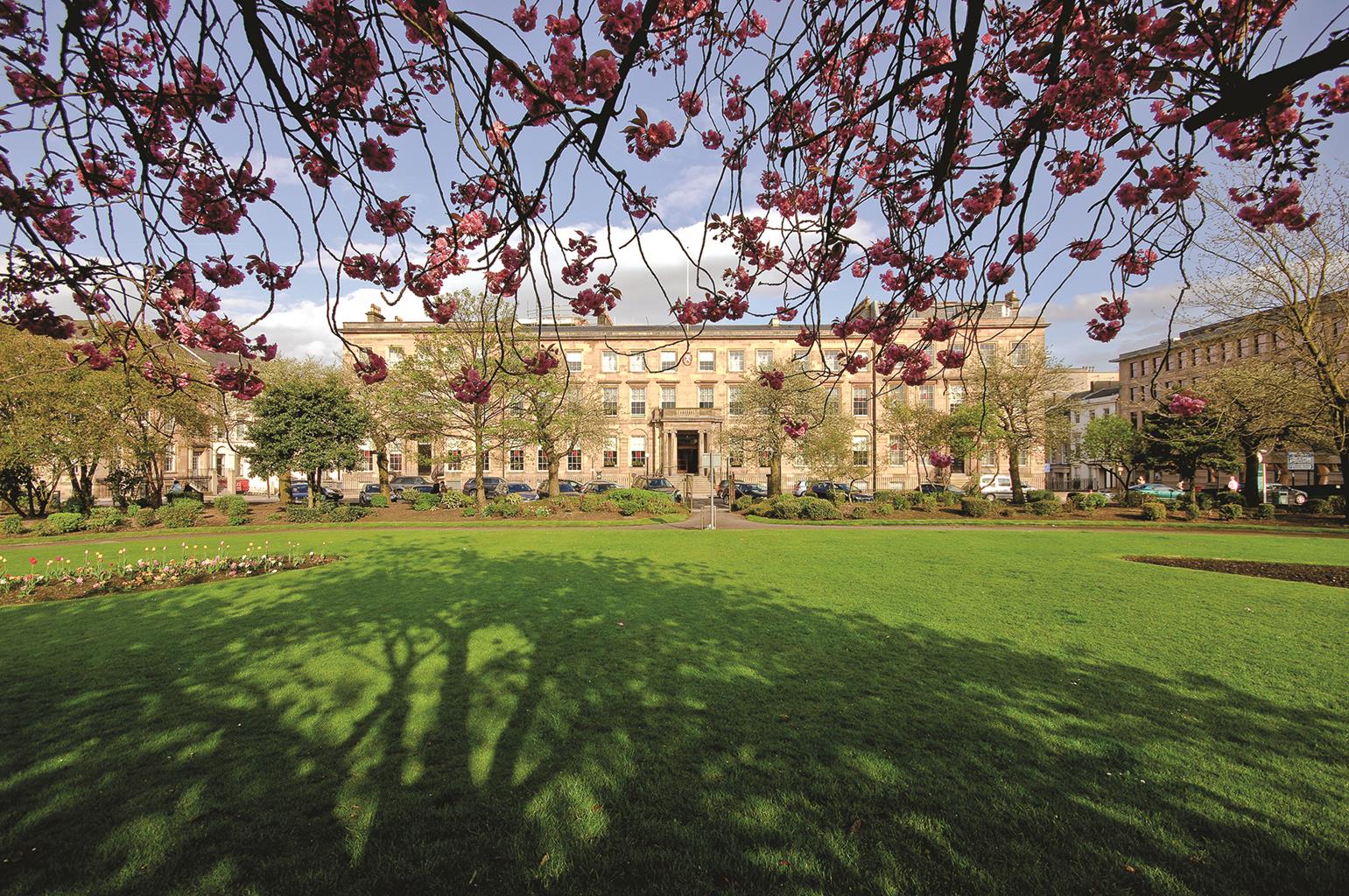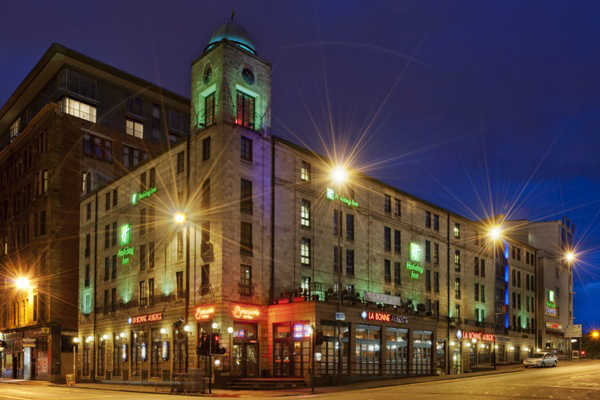Located a moment's walk from Glasgow's shopping centres and central transport links, this…
Alexander 'Greek' Thomson

Discover a Victorian city and the architect who shaped it
6.5 miles (10.4kms)
About the walk
More than any other architect Alexander Thomson was responsible for the shaping of Glasgow with his innovative use and interpretation of classical Greek designs. Born in 1817 in the Stirlingshire village of Balfron, he moved to Glasgow to live with an older brother. He was apprenticed to an architect and began studying the plans, drawings and engravings of classical architecture. This influence dominated his later style and earned him the nickname 'Greek' Thomson although he never travelled abroad.
Classical Influences
The range of his buildings was extraordinary, from churches to villas, warehouses, tenements and even a set of steps. Much of his work was destroyed by German bombing during World War II and even more disappeared in the relentless modernisation of Glasgow during the 1960s and '70s. However, those buildings that have survived provide a fine cross-section of his work. His one remaining church (1857-9) on St Vincent Street is a remarkable building with Grecian columns and an imposing tower, built on the side of Blythswood Hill. Near by, in Union Street, the curiously named Egyptian Halls (1871-3), an enormous stonefronted building with an interior constructed from cast iron, started life as an early form of shopping centre or bazaar. In the West End, near the Botanic Gardens, Thomson created the Great Western Terrace (1869), the 'grandest terrace in Glasgow' and took the unusual step of placing the tallest buildings in the middle of the row, rather than at the ends, which was more conventional at the time. Another example of his terraces, Moray Place (1858), is where Thomson took up permanent residence. His home at No 1 is now the contact address for the Alexander Thomson Society and, like most of the houses he designed, is in private ownership. One exception is Holmwood House (1858) in Cathcart, 4.5 miles (7.2km) from the city centre, now owned by the National Trust for Scotland. Built for a wealthy paper manufacturer, it is an asymmetrical villa with a bay window, which looks like a Greek temple attached to the front of the building. It is probably Thomson's finest work.
Alexander Thomson Society
Although he gained prominence during his lifetime and had a major influence on later architects such as Charles Rennie Mackintosh and Frank Lloyd Wright, Thomson is little known today. Records of his work are limited to a few drawings held in Glasgow's Mitchell Library. His own office archive has vanished without a trace and were it not for the work of the Alexander Thomson Society, he would have remained in obscurity. However after much campaigning to preserve his remaining 24 buildings within the city and the publication of a book about the man, Thomson is beginning to regain the recognition he deserves.
Walk directions
Exit Central Station and turn right. At the junction with Union Street turn right. The building on the opposite corner is the Ca' d'Oro building, a late 19th-century Italianate warehouse by John Honeyman, based on the Golden House in Venice. The upper storeys are made of cast iron. A little way down Union Street from here on the same side as the Ca' d'Oro is Thomson's Egyptian Halls, sadly in need of some renovation.
Cross over then head down Union Street, turning left into Argyle Street at the next junction. Cross Argyle Street, then walk along to the junction with Dunlop Street where you will find the Buck's Head building, named after an inn that previously stood on this spot. Cross Argyle Street again, retrace your steps, turning right into Buchanan Street. Turn left into Mitchell Lane, pass the Lighthouse, then turn right.
Walk up Mitchell Street, continue along West Nile Street then turn left into St Vincent Street. Continue on this for just under 0.5 miles (800m), going uphill to the junction with Pitt Street. You are now standing in front of 'Greek' Thomson's St Vincent Street church, one of his greatest achievements. Cross St Vincent Street here then head up Pitt Street to Sauchiehall Street.
On the opposite corner is Thomson's Grecian Chamber (1865) and to the right along Scott Street is Rennie Mackintosh's Glasgow School of Art. From the front of the Grecian Chamber turn left, head down Sauchiehall Street to Charing Cross, then take the pedestrian bridge over the motorway to Woodlands Road. Go along here until it ends at Park Road, turn right, then left again into Great Western Road.
Go right on Belmont Street, left at Doune Gardens, continue along Doune Quadrant, then left again at Queen Margaret Drive. Cross the road and head down past the Botanic Gardens to turn right, back into Great Western Road. Cross the road and continue to Great Western Terrace, another Thomson masterpiece. Retrace your steps back from here to the top of Byres Road and turn right then, near the bottom, turn left into University Avenue.
Go left into Oakfield Avenue, pass Eton Terrace on the corner with Great George Street. Turn right into Great George Street, right at Otago Street, left into Gibson Street and keep going when it becomes Eldon Street. Turn right into Woodlands Road and return to Sauchiehall Street. Follow this to the junction with Renfield Street, turn right and head downhill to Central Station.
Additional information
City pavements
City streets
Not the best of walks for dogs
OS Explorer 342 Glasgow; AA Street by Street
Sauchiehall Street multi-storey or on-street parking
Central Station
WALKING IN SAFETY
Read our tips to look after yourself and the environment when following this walk.
Find out more
Also in the area
About the area
Discover Glasgow
Scotland’s biggest city is also arguably its youngest. Glasgow may have been founded some 1,500 years ago, but most of what you see today is much more recent. The nightlife is legendary, ranging from a lively clubbing scene to Scottish traditional music in lively bars and pubs. The city claims to be Scotland’s sporting capital, a claim which was reinforced when it was chosen to host the 2014 Commonwealth Games. Football is as much a local obsession as anywhere in Scotland, with all clubs maintaining a keen rivalry.
Glasgow can claim to be one of Scotland’s most ethnically diverse cities, and it has been since the 19th century. Glasgow’s industrial boom created huge demand for labour at a time when both the Scottish Highlands and Ireland were suffering extreme poverty and even famine, so tens of thousands of people migrated to work in Glasgow’s mills and shipyards. The city also had a sizeable Jewish community, and in the late 19th century, large numbers of Italians migrated to the city. About a century later, Glasgow attracted migrants from India, Pakistan and Bangladesh, and as a result you’ll find some of the best Asian food in Scotland here.
Nearby stays
Restaurants and Pubs
Nearby experiences
Recommended things to do
Why choose Rated Trips?
Your trusted guide to rated places across the UK
The best coverage
Discover more than 15,000 professionally rated places to stay, eat and visit from across the UK and Ireland.
Quality assured
Choose a place to stay safe in the knowledge that it has been expertly assessed by trained assessors.
Plan your next trip
Search by location or the type of place you're visiting to find your next ideal holiday experience.
Travel inspiration
Read our articles, city guides and recommended things to do for inspiration. We're here to help you explore the UK.













